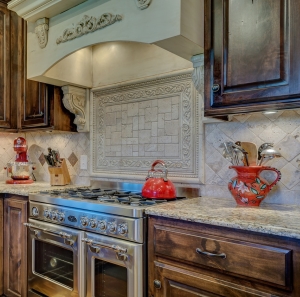Choosing Granite Countertop Finishes

Granite is available in hundreds of colors, including shades of white, black, gray, green, blue, red, pink, yellow and tan. The colors can be bold or muted, patterned, speckled, dotted, veined or a combination. Because each piece of granite is made from a unique mineral makeup, each stone countertop is a unique work of art. And if that wasn’t enough, granite is more than just art. It’s a workhorse in the kitchen. The sharpest knives won’t scratch it, and a bubbling pot won’t mar it. It’s just about as close to the perfect countertop that a homeowner can select.
Lifestyle and Design Considerations when Selecting a Granite Finish
The biggest challenge, after finding the perfect color, pattern, size, and hardness, is picking the best finish for your stone. There are four types of finishes we recommend for granite countertops – polished, honed, leather or brushed. Depending on your family, lifestyle, and how much you use your countertop and what you use it for, each finish provides a “best use” option. While it’s possible for a stone fabricator to change the finish, it can be expensive. It’s better to choose the finish before the stone is installed so the best finish can be applied before the stone is in your home.
-
Traffic
Will your countertop be in an area that receives a significant amount of use and traffic? Then polished granite may be your best choice. A polished granite finish requires less maintenance and is more likely to resist stains. A honed finish can work for high traffic areas if you’re willing to commit to a regular cleaning, sealing, and maintenance schedule. For areas with low traffic, any finish is suitable.
-
Level of Sophistication
Do you entertain? Do you want a more elegant, sophisticated appearance? Then again, polished countertops are ideal. A polished finish is classy and shows all of the granite’s natural beauty. Choose a polished finish if you like to see the color of granite at its best.
Are you more attracted to the subtle and understated look? Then for a more contemporary aesthetic, honed countertops are the most appropriate option. Honed granite is becoming more popular than polished, although both are well received in any home.
Designers may prefer the more rugged appearance of brushed countertops, especially in a home office, bar or outdoor kitchen, but you have the ultimate say. If your designer insists on brushed or a leather look, ask them why they think that finish will work best before deciding.
-
Price and Availability
For most homeowners, it’s the price and availability of the various finishes rather than the final look that decides which finish to use. Because polished finishes are the most popular they’re almost the finish most likely to be in stock. However, honed finishes are growing in popularity, making them frequently available, as well. Any other finish may take longer to obtain, something to consider if timeliness is an issue. The final cost of a piece will depend largely on its availability. While polished granite requires more grinding than honed granite it’s less expensive than honed or brushed because of its high availability.
Making the Final Granite Finish Decision
When selecting a finish, make sure to ask about availability and price, if those are important to you. Also, take time to have your installer not only explain the differences between finishes but show you actual examples. This is especially important if you choose to use a color enhancing sealer. This kind of sealer mimics and restores the color of the stone without actually restoring the shine that comes with a polished surface.
Natural stones with a polished finish will most likely have more pronounced colors and hues. Essentially, honing takes away the depth and hues that are brought out by the polished coat. The result is that you may end up with a lighter colored slab. Many people hone their stone to make it lighter and brighter.
-
Polished Granite Finish
When a stone is polished, the details, colors, hues, and vein structure of the stone are more prominent. A polished finish puts more of an emphasis on the natural characteristics of the stone—which can be stunning if you’ve found a stone with great coloring or features. A high polish finish will bring the stone’s natural color to its fullest because it will ultimately reflect the light and appear more saturated. A polished finish is the least porous option, which is great if you have kids, or tend to spill things. It’s the most popular finish among homeowners because of the rich, luxurious look. A polished stone is a smooth, reflective surface that draws out the color and texture of your stone, giving the countertop a rich look. With all that shine comes one minor problem—that shiny surface also accents any crumbs, imperfections in the stone, and dirt or dust. The upside of a polished finish is it is the easiest to clean.
-
Honed Granite Finish
To create a honed finish, manufacturers use coarser abrasives and stop grinding the stone before its surface becomes shiny. This leaves the stone with a satin or matte appearance. While still smooth, this finish is not shiny and reflective. Think of the difference between a high gloss paint and a satin paint. Honed is more muted, like satin. Because honed granite is not reflective and shiny like a polished stone, it will not show all of the color and texture of the granite stone as well as a polished finish will. However, some homeowners prefer this more subtle appearance over the glossiness of polished granite. This matte finish does cut down on glare and it masks imperfections. It’s a good choice for kitchens with lots of lights or windows because of glare.The surface is slightly more porous. The depth, hues, and veins are not as evident. The degree of honing depends on the stone but may vary from light to heavy. Many people hone their stone to make it lighter and brighter. Others may want to keep some of the colors and hues and may opt for a color-enhancing sealer to use with the honed finish.
-
Leather Granite Finish
A leather finish is created when fabricators move diamond-tipped brushes across the surface. This alters the stone somewhat, giving it the look and feel of textured leather. A leather finish combines the best of a polished surface – making the stone less porous while highlighting the color; while also disguising crumbs and streaks like a honed surface. It requires no extra care or maintenance, and owners report that they love the finish and the texture.
-
Brushed Granite Finish
To create a brushed finish, manufacturers gently brush the granite’s surface until it becomes textured and appears worn-in. Because of the brushing process, granite countertops with this finish are more porous in comparison to polished granite. Like a honed finish, a brushed finish dilutes the color of the granite. Brushed finishes are the most likely to become stained when they aren’t properly sealed and maintained. If not cleaned or used frequently, dust and debris tend to accumulate in the uneven surface of a brushed finish, so it needs more cleaning and maintenance.
Whichever finish you choose, make sure you see an actual example of it on a stone. All stone fabricators will have examples of sealers, enhancers, and finishes they can use on your stone.
Contact us at any time if you have questions about selecting a great finish for your granite countertops!


